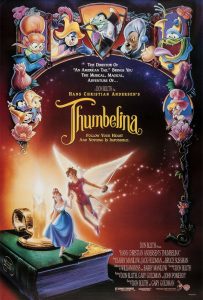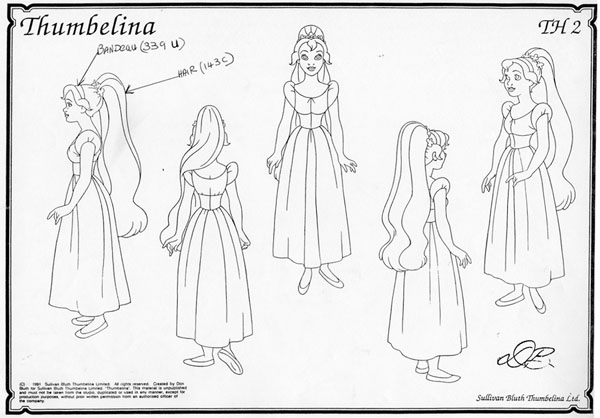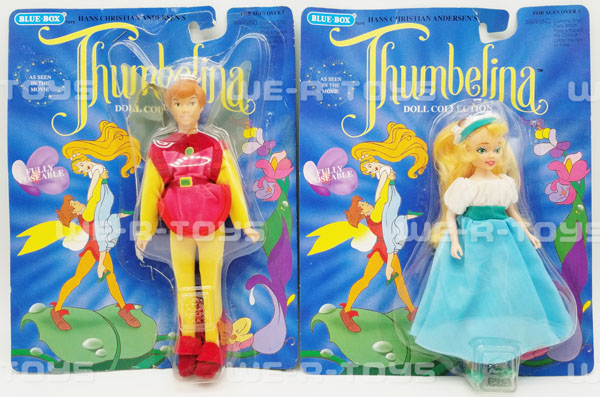


 Thumbelina is based on a timeless story, but the movie is a product of its time.
Thumbelina is based on a timeless story, but the movie is a product of its time.
Celebrating its 30th anniversary this year, the film was released to theaters amid the animation renaissance of the ’90s, several years after Disney’s Beauty and the Beast and Aladdin and just three months before The Lion King would achieve landmark blockbuster status.
Like numerous “non-Disney” animated films at the time, Thumbelina is one of many not released by the ol’ Mouse House that looked to replicate the Disney paradigm in form, in feeling, in every way.
This is ironic in that the film was co-directed by Don Bluth and Gary Goldman. The two were part of a much-discussed walk-out of animators from the Disney studio in 1979 and went on to direct such 80s animated hits as An American Tail (1986) and The Land Before Time (1988). When Thumbelina was released, critic Roger Ebert noted, “Bluth originally left Disney because he found the studio’s animation efforts moribund. The irony is that his own films now more closely resemble the Disney of the 1970s than those from the current studio.”
Ebert was one of the many who didn’t care for Thumbelina, but there is a solid, nostalgic connection for those who grew up with the film, particularly on subsequent VHS viewings. Just scan through the glowing user reviews on IMDb, and it’s clear that Bluth’s audience for Thumbelina has stayed faithful to the film over the past three decades.

Opening on a lovely shot of Paris, the film, based on the famous story by Hans Christian Andersen, is narrated by a swallow named Jacquimo, who tells us the tale of a lonely widow who longs to have a child.
Seeking guidance from a witch, she is given a seed that, when planted, blooms into a flower, and inside is a tiny girl that the widow names Thumbelina. The woman raises Thumbelina, but the tiny girl yearns to meet someone her own size.
 Late one night, Thumbelina meets Cornelius, the fairy prince, who is the same size as her. They are so enchanted with each other that Thumbelina flies off with Cornelius on his bumble bee.
Late one night, Thumbelina meets Cornelius, the fairy prince, who is the same size as her. They are so enchanted with each other that Thumbelina flies off with Cornelius on his bumble bee.
While out in the world, Thumbelina has a number of adventures as she attempts to find her way back home. Cornelius tries to find her, she is kidnapped by Mrs. Toad and her son Grundel, and Mrs. Toad looks to arrange a marriage between Thumbelina and her son. Thumbelina meets the slick Berkeley Beetle, who promises to help her get home, but first, she must accompany him to the Beetle Ball; Thumbelina takes refuge in the home of Miss Fieldmouse and winds up forced to marry Mr. Mole, but course, Cornelius eventually finds his way to Thumbelina and, spoiler alert, they live happily ever after.
Bluth and Goldman employ lush animation and character design in Thumbelina that does indeed harken back to previous Disney films, as well as Richard Williams’ Raggedy Ann and Andy, and a little of the Fleischer Bros. There’s quite a bit of rotoscoping used to bring Thumbelina and Cornelius to the screen, but the more anthropomorphized players are brought to the life with pleasant character design.
 One only wishes that this artistry was partnered with a stronger story that allowed for some emotional attachment to the characters. Thumbelina’s songs are from Barry Manilow and William Ross, two tremendous talents who deliver serviceable and some humorous songs, most notably, the campy “Marry the Mole,” sung by none other than Carol Channing as Mrs. Fieldmouse.
One only wishes that this artistry was partnered with a stronger story that allowed for some emotional attachment to the characters. Thumbelina’s songs are from Barry Manilow and William Ross, two tremendous talents who deliver serviceable and some humorous songs, most notably, the campy “Marry the Mole,” sung by none other than Carol Channing as Mrs. Fieldmouse.
The rest of the voice cast in Thumbelina includes Gary Imhoff as Cornelius, Gino Conforti as Jacquimo, John Hurt as Mr. Mole, Charo as Mrs. Toad, Kenneth Mars as King Colbert of the Fairies, and voice acting legend June Foray as Queen Tabitha.
Two other members of the cast were closely associated with Disney: The Little Mermaid’s Ariel herself, Jodi Benson is Thumbelina, and Berkeley Beetle is voiced by Gilbert Gottfried, who had voiced Iago, the villainous sidekick parrot in Aladdin (1992).
The Disney influence on Thumbelina carried over even to the film’s early promotion. In Jerry Beck’s book, The Animated Movie Guide contributor W.R. Miller wrote: “According to John Horn in the Los Angeles Times, June 1, 1997, Warner Bros. held two test screenings. In the first screening, the audience reaction was flat. In the second screening, Warner Brothers. prefaced the film with the Disney logo. The audience’s response was more favorable.”

Thumbelina dolls
Unfortunately, such tactics didn’t work, and Thumbelina fared poorly well at the box office. Also, the kitschy “Marry the Mole” garnered a dubious Razzie Award for Worst Original Song.
Not long after the film’s release on March 30, 1994, 20th Century Fox announced their new animation studio to be headed by Bluth and Goldman, and the first film would be Anastasia, which would be a significant contender to Disney’s dominance during the decade.
“Competition is always a good thing,” said Bluth in a 1997 interview. “Every person is important; every person has some little bit of truth that everybody should see and hear. When all these artists get together under the umbrella of a studio and decide to make a picture, I think that they’re going to make something that’s noteworthy. Now, whether it’s commercial, by that yardstick meaning that it will make money, you don’t know. But I think competition is wonderful because it keeps us all looking over our shoulders, slightly, to see how good a job we can really do.”